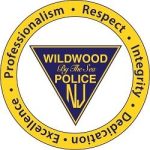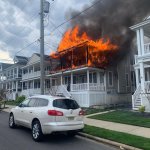CAPE MAY – When most people head to the beach, they usually carry chairs, lotions, umbrellas and snacks among other items. When Wayne and Barbara Schlueter headed to the beach June 1, they brought not only chairs, umbrellas and snacks, but also brought antennas, a transceiver and a Morse code translator to use their portable ham radios and see who they could talk with during the afternoon.
Loaded with portable solar panels, the radio equipment and homemade antennae, the Schlueters, who were visiting family in Cape May, connected with other ham radio operators along a north-south corridor including Florida, Georgia, North Carolina, Wisconsin, Ohio, Minnesota and Ireland during a sunny afternoon at the beach.
“Our favorite thing is to go portable,” Barbara said. “The best place for signals is near the water, but you can’t get sand in the equipment.”
“It’s like fishing,” her husband added. “You throw out your call sign and see who is listening.”
Amateur radio (ham radio) is a hobby and service that brings people, electronics and communication together, according to the Amateur Radio Relay League (ARRL). People use a ham radio to talk across town, around the world, or even into space, all without the internet or cell phones.
For Schlueter, whose call signal is KD0WAT, and his wife, whose call signal is KD0WAU, it’s an opportunity to combine “old technology with new” to help their community’s emergency response team in their hometown of Andover, Kan.
They became operators about four years ago, using her background in information technology and his as a mechanical engineer to share a new hobby, make new friends and help others.
“As volunteers, we help communities who are hit by tornadoes, flooding, and in search and rescue efforts,” Barbara said.
“We’ve helped find a man who drowned in his car during a flood; we can provide help with traffic and perimeter control, and we can send images without the internet so when the Red Cross needs to know how big or how bad something is, we can send photos so they can provide the necessary emergency equipment and supplies. Any place portable communications are required, we can be there to help relay messages.”
“In this technology era, when all else fails, when the cell towers are down, we are still up,” Schlueter added.
The couple is not the first in their families to become ham radio operators: Barbara’s son, brother, father and father-in-law also have been or are operators.
The Federal Communications Commission (FCC) grants licenses to operate on radio frequencies known as amateur bands after certain tests are passed about radio theory, regulations, and operating practices.
“It’s not really that expensive of a hobby,” Schlueter said, noting the exam costs less than $50.
The first-level certification allows the operator to communicate locally and most often in North America; the second level opens the door to worldwide communications, and the third level provides operators with privileges on all bands and modes.
Both Schlueters have achieved the third level license. Equipment can range from $30 for a used radio to $400 or more for new equipment.
“When we go to a disaster site, we usually take our $30 radio in case it falls into the flood waters,” Barbara noted. “We’ve learned how to send email, attachments, and photos over the airwaves, so we’re combining digital technology with the old.”
“It’s the original social networking,” Schlueter added.
The first wireless operators were landline telegraphers who left their offices to go to the sea or man the coastal stations, according to the National Association for Amateur Radio (NAAR).
They brought with them their language and much of the tradition of their older profession.
Looking at the dial on an AM radio, frequencies are marked from 535 to 1605 kilohertz, according to the NAAR website. This is one radio “band.” There are other bands for amateur, government, military and commercial radio uses.
If you could hear the many different bands, you would find aircraft, ships, fire and police communication, as well as “shortwave” stations, which are worldwide commercial and government broadcast stations from the U.S. and abroad.
Amateurs are allocated 26 bands, or specific groups of frequencies, to talk across town, around the world or to satellites in space.
Hams can even bounce signals off the moon.
Barbara said afternoons spent talking to people like the time spent at the beach recently provide the practice they need to keep their skills sharp for emergency situations.
She noted that she didn’t hear a lot of women on the airwaves, although she would meet them at various ham radio events, so she started a Tuesday night ham radio event for women, called YL Net.
“It’s the Young Ladies Network,” she explained, “only for women, no matter what their age.”
A new Facebook page was initiated called Ladies on the Air, and their website is https://www.qrz.com.
Some of the women have just earned their licenses while others earned their licenses 20 or 30 years ago but never used their skills on the air, according to Barbara. “We’ve met for 45 consecutive weeks, and some of the ladies are now on the air on a regular basis. We do an hour of just us ladies, and then we invite the men to join us.
“It keeps us busy, and we’ve met some wonderful people,” she added.
Once contact is made with another operator, information is exchanged and a card sent via snail mail confirming contact was made. “We’ve got cards from all over,” Schlueter said, “including Greece, Italy, Ireland, Australia, and Russia.”
Besides helping with the emergency response team, the Schlueters take their portable equipment to places like Teter Rock, Kan. for special ham radio events called contesting.
“We stay for two days and call all over the world,” Barbara said. “Teter Rock is in the middle of nowhere, and all around us, we see cattle, wild mustangs, and the Kansas prairie. It’s gorgeous, and it gives us another chance to practice.”
While visiting family in Cape May, the couple enjoyed talking with beachgoers and others who happened upon them in between talking with other hams.
They would be heading home shortly, stopping about every 250 miles, where they would unload their equipment and set up ham operations for the evening.
When they eventually get home, they plan to help with a country western festival.
“They expect about 20,000 cars, and we’ll be there to help park them,” Schlueter said. “It gives us practice on how to handle crowds and cars, and that experience can help during emergency situations.”
To contact Karen Knight, email kknight@cmcherald.com.
Wildwood Crest – In NY City there are hundreds of "migrants" from Africa protesting because the housing and food they are given is not good enough. They say they deserve better. Their representative went in…








